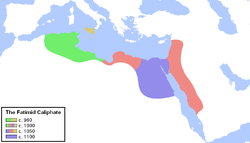Fatimid Caliphate
Appearance
(Reguidit frae Fatimid Islamic Caliphate)
Fatimid Islamic Caliphate الدولة الفاطمية ad-Dawlat al-Fāṭimiyya | |||||||||||||||||||||||
|---|---|---|---|---|---|---|---|---|---|---|---|---|---|---|---|---|---|---|---|---|---|---|---|
| 909–1171 | |||||||||||||||||||||||
|
Fatimid green banner.[1] | |||||||||||||||||||||||
 | |||||||||||||||||||||||
| Caipital |
| ||||||||||||||||||||||
| Common leids | Arabic (offeecial), Berber | ||||||||||||||||||||||
| Releegion | Ismaili Shia Islam | ||||||||||||||||||||||
| Govrenment | Caliphate | ||||||||||||||||||||||
| Caliph | |||||||||||||||||||||||
• 909–934 (first) | al-Mahdi Billah | ||||||||||||||||||||||
• 1160–1171 (last) | al-'Āḍid | ||||||||||||||||||||||
| Historical era | Early Middle Ages | ||||||||||||||||||||||
• Established | Januar 5 909 | ||||||||||||||||||||||
• Foondation o Cairo | August 8, 969 | ||||||||||||||||||||||
• Disestablished | 1171 | ||||||||||||||||||||||
| Aurie | |||||||||||||||||||||||
| 969[2] | 4,100,000 km2 (1,600,000 sq mi) | ||||||||||||||||||||||
| Population | |||||||||||||||||||||||
• | 6,200,000 | ||||||||||||||||||||||
| Currency | Dinar | ||||||||||||||||||||||
| |||||||||||||||||||||||
| The day pairt o | |||||||||||||||||||||||
The Fatimid Caliphate (Arabic: الفاطميون, al-Fāṭimīyūn) wis a Shia Islamic caliphate, which spanned a muckle aurie o North Africae, frae the Reid Sea in the east tae the Atlantic Ocean in the wast.
References
[eedit | eedit soorce]- ↑ Ibn Hammad (d. 1230) in Akhbar al-Muluk Bani Ubayd (ed. Paris, 1927, p. 57) mentions that Ismail al-Mansur in 948 after his victory over Abu Yazid was met at Kairwan by the notables mounted on fine horse and carrying drums and green flags. While green is often referred to as the dynastic colour of the Fatimids, it appears that the Fatimid caliphate did also use white, in opposition to the black used by the Abbasid caliphate. "The Ismaili Shiʿite counter-caliphate founded by the Fatimids took white as its dynastic color, creating a visual contrast to the ʿAbbasid enemy ... white became the Shiʿite color, in deliberate opposition ot the black of the ʿAbbasid 'establishment'." Jane Hathaway, A Tale of Two Factions: Myth, Memory, and Identity in Ottoman Egypt and Yemen, 2012, p. 97f.
- ↑ Turchin, Peter; Adams, Jonathan M.; Hall, Thomas D (December 2006). "East-West Orientation of Historical Empires" (PDF). Journal of world-systems research. 12 (2): 219–229. Archived frae the original (PDF) on 22 Februar 2007. Retrieved 9 Januar 2012.

